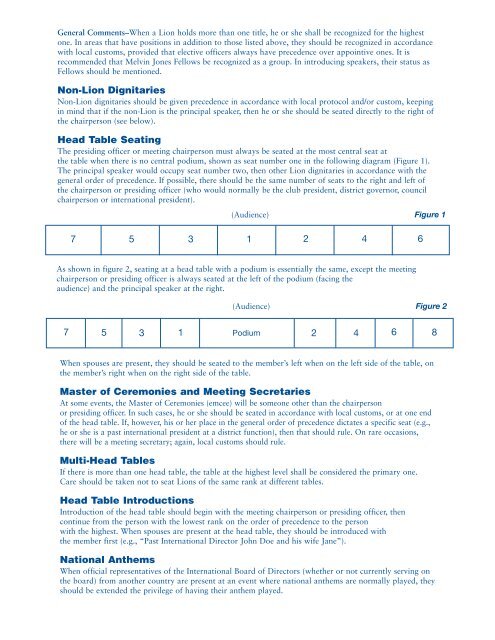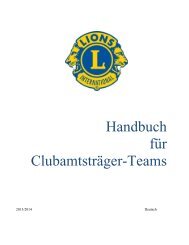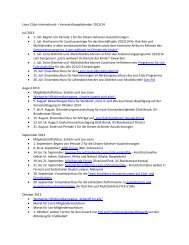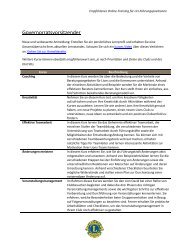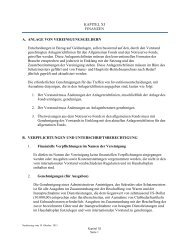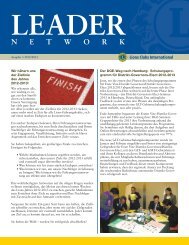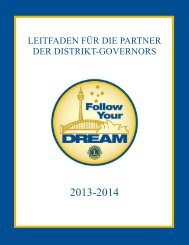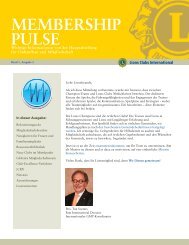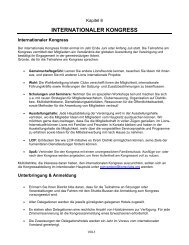A Hosting & Protocol Guide (pr768.pdf) - Lions Clubs International
A Hosting & Protocol Guide (pr768.pdf) - Lions Clubs International
A Hosting & Protocol Guide (pr768.pdf) - Lions Clubs International
You also want an ePaper? Increase the reach of your titles
YUMPU automatically turns print PDFs into web optimized ePapers that Google loves.
General Comments–When a Lion holds more than one title, he or she shall be recognized for the highest<br />
one. In areas that have positions in addition to those listed above, they should be recognized in accordance<br />
with local customs, provided that elective officers always have precedence over appointive ones. It is<br />
recommended that Melvin Jones Fellows be recognized as a group. In introducing speakers, their status as<br />
Fellows should be mentioned.<br />
Non-Lion Dignitaries<br />
Non-Lion dignitaries should be given precedence in accordance with local protocol and/or custom, keeping<br />
in mind that if the non-Lion is the principal speaker, then he or she should be seated directly to the right of<br />
the chairperson (see below).<br />
Head Table Seating<br />
The presiding officer or meeting chairperson must always be seated at the most central seat at<br />
the table when there is no central podium, shown as seat number one in the following diagram (Figure 1).<br />
The principal speaker would occupy seat number two, then other Lion dignitaries in accordance with the<br />
general order of precedence. If possible, there should be the same number of seats to the right and left of<br />
the chairperson or presiding officer (who would normally be the club president, district governor, council<br />
chairperson or international president).<br />
(Audience) Figure 1<br />
7 5 3 1 2 4 6<br />
As shown in figure 2, seating at a head table with a podium is essentially the same, except the meeting<br />
chairperson or presiding officer is always seated at the left of the podium (facing the<br />
audience) and the principal speaker at the right.<br />
(Audience) Figure 2<br />
7 5 3 1 Podium<br />
2 4 6 8<br />
When spouses are present, they should be seated to the member’s left when on the left side of the table, on<br />
the member’s right when on the right side of the table.<br />
Master of Ceremonies and Meeting Secretaries<br />
At some events, the Master of Ceremonies (emcee) will be someone other than the chairperson<br />
or presiding officer. In such cases, he or she should be seated in accordance with local customs, or at one end<br />
of the head table. If, however, his or her place in the general order of precedence dictates a specific seat (e.g.,<br />
he or she is a past international president at a district function), then that should rule. On rare occasions,<br />
there will be a meeting secretary; again, local customs should rule.<br />
Multi-Head Tables<br />
If there is more than one head table, the table at the highest level shall be considered the primary one.<br />
Care should be taken not to seat <strong>Lions</strong> of the same rank at different tables.<br />
Head Table Introductions<br />
Introduction of the head table should begin with the meeting chairperson or presiding officer, then<br />
continue from the person with the lowest rank on the order of precedence to the person<br />
with the highest. When spouses are present at the head table, they should be introduced with<br />
the member first (e.g., “Past <strong>International</strong> Director John Doe and his wife Jane”).<br />
National Anthems<br />
When official representatives of the <strong>International</strong> Board of Directors (whether or not currently serving on<br />
the board) from another country are present at an event where national anthems are normally played, they<br />
should be extended the privilege of having their anthem played.


